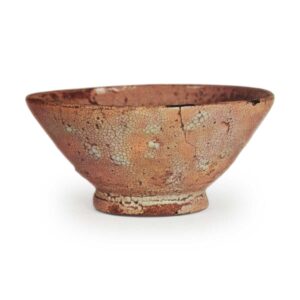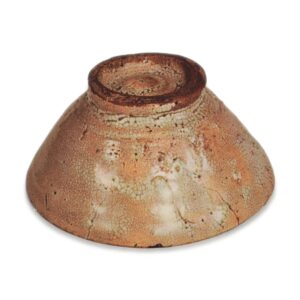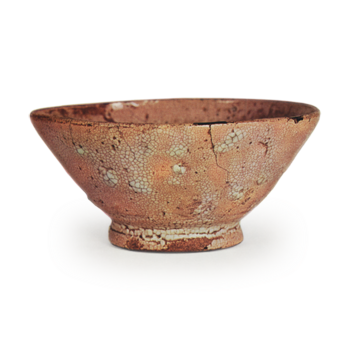

Height: 5.8 – 6.2cm
Diameter: 12.5 – 21.6cm
Outer diameter of foot ring: 5.9cm
Height of foot ring: 1.0cm
This teacup has a rare shape for a teacup with a large foot ring. The most attractive feature of this teacup is the glaze that flows down the inside of the cup, and it is likely that the name Iwashimizu was given to this teacup because it resembles the clear water that flows over rocks. There is another well with the name “Ishizumi” that was a favorite of Masuda Don’o, but this seems to be a larger well, and it is different from this tea bowl.
The clay is a rough clay with a little iron content, and it is covered in a white, cloudy, translucent glaze. The tatami mat is exposed. The glazed surface is dull and cloudy, and the thinly glazed areas are finely detailed, while the thickly glazed areas have rough cracks all over. As the base material contains little iron, the tea bowl has a somewhat pale feel to it, like Kaga or Bousui, and has a simple and elegant feel. The firing is slightly oxidized, and the overall color is a pale loquat color, but the areas where the glaze has pooled have a hint of blue. The shape is shallow and flat, and the body is slightly stretched and close to a straight line, but the wide, large foot is noticeable. The well-known teacups with a large foot compared to the body are Asano and Otakara for large cups, Rikyu, Kanbayashi, Esumi and Kohama for small cups, and Nagasaki, Soko, Kodama, Kimpo and Ryoju for blue cups. The closest in appearance is Ryoyu from Aoido, but this bowl has a wider, more expansive feel to the upper part of the rim than Ryoyu. There are no other tea bowls from Ido that have such a wide, expansive feel to the upper part of the rim, so this is a unique piece even among Ido tea bowls.
The most attractive feature of this tea bowl is the glaze on the inside, which has a subtle bluish tinge and flows gently into the bowl. There are five marks close to the rim, and three small frayed marks on the rim.
These have been repaired with black lacquer, and there are eight vertical grooves of various sizes, but there are no particularly noticeable flaws.
The history of its transmission is not known, but on the back of the outer box there is a
sticker with the following written on it
This bowl was originally owned by the Konoike family of Osaka
and the inside of the inner box is decorated with powdered gold
brushwork by Ganjuro Hosetsu
Sōyū wrote this, and his seal is on it
There is a label attached to the inside of the box that says “Kono utsuwa, Konoike-ke denrai, Osaka” (This tea bowl was passed down in the Konoike family of Osaka), but the details are unknown. The inner box is made of mulberry wood, with gold powder lettering and a border of maki-e lacquer.
This well was not well known to the general public, but in March 1965, when a memorial service was held for Seiichi Okuda and Rakunoken Wakimoto at the Tokyo National Museum, it was used for the first time at a tea ceremony at Rokusouan and was well received.



